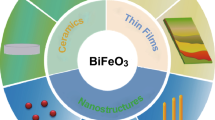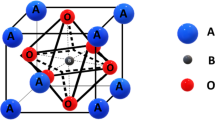Abstract
Due to the abundant dielectric, ferroelectric, piezoelectric, and pyroelectric properties, dielectrics have found extensive applications in various fields. Particularly, the environmentally friendly and lead-free (1 − x)Bi0.5Na0.5TiO3−xBi0.5K0.5TiO3 (BNT-BKT) has attracted wide attention because of its well electrical polarization performance at the morphotropic phase boundary. Currently, so much research has been conducted on the property regulation of the BNT-BKT-based materials. However, there is still limited investigation into the influence of process parameters on electrical behavior using wet chemical methods. Meanwhile, the underlying mechanism also remains unclear. In this work, a series of BNT-BKT samples with fixed proportion have been prepared through adjusting the concentration of alkaline solution in hydrothermal method, followed by a detailed exploration of the microstructure, morphology, and various electrical polarization properties. The results indicate that BNT-BKT samples undergo the transition from rhombohedral to orthorhombic phase with increasing hydrothermal concentration. Moreover, higher concentration can effectively suppress the formation of strip-like grains due to element segregation. Furthermore, the enhancement in growth and stability of electric domains is observed, as well as the intensity and stability of electrical polarization behavior. The findings have guiding significance in performance modulation of lead-free dielectric materials and the design of related electronic devices.




Similar content being viewed by others
Data availability
Data will be made available on reasonable request.
References
A.A. Balaraman, S. Dutta, Inorganic dielectric materials for energy storage applications: a review. J. Phys. D: Appl. Phys. 55, 183002 (2022)
H. Chen, Z. Pan, Y. Cheng, X. Ding, J. Liu, Q. Chi, M. Yang, J. Yu, Z.-M. Dang, Ultrahigh charge-discharge efficiency and high energy density of a high-temperature stable sandwich-structured polymer. J. Mater. Chem. A 10, 1579–1587 (2022)
P. Li, Y. Zhao, H. Li, T. Zhai, On the working mechanisms of molecules-based Van Der Waals dielectrics. Small. 19, 2302230 (2023)
Y. Cao, J. Lin, Y. Shi, G. Li, C. Shi, K. Zhu, G. Ge, C. Chen, F. Yan, W. Yang, L. Xu, B. Shen, J. Zhai, High piezoelectricityin eco-friendly NaNbO3-based ferroelectric relaxor ceramics via phase and domain engineering. ACS Appl. Mater. Interfaces. 15, 5399–5410 (2023)
S. Bandyopadhyay, S.M. Vaishnavi, T. Jogi, R. Ramadurai, S. Bhattacharyya, Role of electrostriction on domain switching near the morphotropic phase region in a ferroelectric solid solution: thermodynamic analysis and phase-field simulations. Phys. Rev. B 108, 134116 (2023)
S.H. Kweon, E.-J. Kim, G. Tan, I. Kanno, Compositional modification of epitaxial Pb(Zr,Ti)O3 thin films for high-performance piezoelectric energy harvesters. Adv. Mater. Interfaces 11, 2300634 (2024)
L.G. Wang, X.F. Su, C.M. Zhu, G.B. Yu, R.T. Huang, Influence of NaNbO3 addition to Bi0.5(Na0.8K0.2)0.5TiO3 lead-free ceramics on the energy storage properties. Solid State Commun. 371, 115259 (2023)
D. Yang, J. Han, J. Yin, H. Xue, J. Wu, Tailoring depolarization temperature by phase transition causing properties evolution in Bi0.5(Na1 – xKx)0.5TiO3 ceramics. J. Mater. Sci. Technol. 114, 111–119 (2022)
Y. Zhang, R. Chu, Z. Xu, J. Hao, Q. Chen, F. Peng, W. Li, G. Li, Q. Yin, Piezoelectric and dielectric properties of Sm2O3-doped 0.82Bi0.5Na0.5TiO3-0.18Bi0.5K0.5TiO3 ceramics. J. Alloy Compd. 502, 341–345 (2010)
A. Sasaki, T. Chiba, Y. Mamiya, E. Otsuki, Dielectric and piezoelectric properties of (Bi0.5Na0.5)TiO3-(Bi0.5K0.5)TiO3 systems. Jpn J. Appl. Phys. 38, 5564–5567 (1999)
L.K. Pradhan, R. Pandey, S. Kumar, S. Kumari, M. Kar, Evidence of compositional fluctuation induced relaxor antiferroelectric to antiferroelectric ordering in Bi0.5Na0.5TiO3- Bi0.5K0.5TiO3 based lead free ferroelectric. J. Mater. Sci-Mater El. 30, 9547–9557 (2019)
A. Moosavi, M.A. Bahreavar, A.R. Aghaei, P. Ramos, M. Algueró, H. Amorín, High-field electromechanical response of Bi0.5Na0.5TiO3-Bi0.5K0.5TiO3 across its morphotropic phase boundary. J. Phys. D: Appl. Phys. 47, 055304 (2014)
S.Y. Cho, S.-H. Han, B.H. Kim, M.-K. Lee, S.W. Wi, Y.S. Lee, S.D. Bu, Enhanced energy storage performance and thermal stability in relaxor ferroelectric BNKT-BBN solid solution ceramics. Mater. Chem. Phys. 314, 128864 (2024)
T. Wang, X.M. Chen, Y.Z. Qiu, H.L. Lian, W.T. Chen, Microstructure and electrical properties of (1-x)[0.8Bi0.5Na0.5TiO3-0.2Bi0.5K0.5TiO3]-xBiCoO3 lead-free ceramics. Mater. Chem. Phys. 186, 407–414 (2017)
S. Supriya, Crystal structure engineered non-toxic Bi0.5Na0.5TiO3 based thin filmsfabrication process, enhanced electrical performance, challenges and recent reports. J. Inorg. Organomet. P. 33, 3013–3026 (2023)
F. Wang, C.M. Leung, Y. Tang, T. Wang, W. Shi, Composition induced structure evolution and large strain response in ternary Bi0.5Na0.5TiO3-Bi0.5K0.5TiO3-SrTiO3 solid solution. J. Appl. Phys. 114, 164105 (2013)
N.P.M.J. Raj, G. Khandelwal, S.-J. Kim, 0.8BNT-0.2BKT ferroelectric-based multimode energy harvester for self-powered body motion sensors. Nano Energy. 83, 105848 (2021)
H. Xi, L. Yu, H. Qian, F. Chen, M. Mao, Y. Liu, Y. Lyu, Large strain with low hysteresis in Sn-modified Bi0.5(Na0.75K0.25)0.5TiO3 lead-free piezoceramics. J. Mater. Sci. 55, 1388–1398 (2020)
J. Camargo, A.P. Espinosa, L. Ramaji, M. Castro, Influence of the sintering process on ferroelectric properties of Bi0.5(Na0.8K0.2)0.5TiO3 lead-free piezoelectric ceramics. J. Mater. Sci-Mater El. 29, 5427–5432 (2018)
W. Wang, Z. Han, H. Wang, X. Wei, R. Zhong, J. Qi, Construction of Co/Mn-based nanowires with adjustable surface state for boosting lean methane catalytic oxidation. Ceram. Int. 50, 2293–2302 (2024)
R. Roukos, J. Romanos, S.A. Dargham, D. Chaumont, Evidence of a stable tetragonal (P4bm) phase in rhombohedral (R3c) complex perovskite (Na1/2Bi1/2)1–xCaxTiO3 lead-free piezoelectric materials. Mater. Sci. Eng. B-Adv. 288, 116196 (2023)
L.G. Wang, X.X. Huang, C.M. Zhu, G.B. Yu, X.F. Su, R.T. Huang, H.X. Qin, W.J. Kong, Structure transition and electric properties in lead-free (Na0.5K0.5)1–xAgxNb1–xTaxO3 ceramics with the polymorphic phase boundary region. J. Solid State Chem. 316, 123552 (2022)
N. Alyabyeva, A. Ouvrard, I. Lindfors-Vrejoiu, O. Ageev, D. McGrouther, Back-scattered electron visualization of ferroelectric domains in a BiFeO3 epitaxial film. Appl. Phys. Lett. 111, 222901 (2017)
N. Pradhani, P.K. Mahapatra, R.N.P. Choudhary, A.K. Jena, J. Mohanty, Investigation on the effect of Mn substitution on the structural, electrical and ferroelectric characteristics of Bi0.5Na0.5TiO3 ceramic. Mater. Res. Bull. 119, 110566 (2019)
W. Jo, S. Schaab, E. Sapper, L.A. Schmitt, H.J. Kleebe, On the phase identity and its thermal evolution of lead free (Bi1/2Na1/2)TiO3–6 mol% BaTiO3. J. Appl. Phys. 110, 074106 (2011)
L. Li, M. Xu, Q. Zhang, P. Chen, N. Wang, D. Xiong, B. Peng, L. Liu, Electrocaloric effect in La-doped BNT–6BT relaxor ferroelectric ceramics. Ceram. Int. 44, 343–350 (2018)
M. Javed, A.A. Khan, J. Kazmi, N. Akbar, N. Ahmed, S.N. Khisro, M.A. Mohamed, Investigation on electrical transport and dielectric relaxation mechanism in TbCrO3 perovskite orthochromite. J. Alloy Compd. 955, 170181 (2023)
A. Adukkadan, R. Ranjan, V. Kumar, High pyroelectric performance and its dependence on the field-induced orientation in antiferroelectric PLZST system. J. Am. Ceram. Soc. (2024). https://doi.org/10.1111/jace.19713
A. Martin, N.H. Khansur, U. Eckstein, K. Riess, K. Kakimoto, K.G. Webber, High temperature piezoelectric response of polycrystalline Li-doped (K,na)NbO3 ceramics under compressive stress. J. Appl. Phys. 127, 114101 (2020)
R.P. Wang, K. Wang, F.Z. Yao, J.F. Li, F.H. Schader, K.G. Webber, W. Jo, J. Rӧdel, Temperature stability of lead-free niobate piezoceramics with engineered morphotropic phase boundary. J. Am. Ceram. Soc. (2015). https://doi.org/10.1111/jace.13604
F. Li, Z. Xu, X.Y. Wei, X. Yao, Determination of temperature dependence of piezoelectric coefficients matrix of lead zirconate titanate ceramics by quasi-static and resonance method. J. Phys. D: Appl. Phys. 42, 095–417 (2009)
Funding
This work was supported by Natural Science Foundation of Guangxi Province (No. 2023JJA110088), the Central Government Guidance Funds for Local Scientific and Technological Development, China (No. Guike ZY22096024), Middle-aged and Young Teachers’ Basic Ability Promotion Project of Guangxi (No. 2023KY0065) and Innovation and Entrepreneurship Program for College Students of Guangxi (No. 202210602063).
Author information
Authors and Affiliations
Contributions
L.G. Wang: software, formal analysis, writing-original draft, funding acquisition, C.H. Jiang: resources, investigation, formal analysis, funding acquisition, C.M. Zhu: conceptualization, validation, data curation, writing-review and editing, supervision, project administration, funding acquisition, Y.Q. Lv: software, investigation, H.Z. Dai: methodology, formal analysis, G.B. Yu: data curation, funding acquisition.
Corresponding author
Ethics declarations
Competing interest
The authors declare that they have no known competing financial interests or personal relationships that could have appeared to influence the work reported in this paper.
Additional information
Publisher’s Note
Springer Nature remains neutral with regard to jurisdictional claims in published maps and institutional affiliations.
Rights and permissions
Springer Nature or its licensor (e.g. a society or other partner) holds exclusive rights to this article under a publishing agreement with the author(s) or other rightsholder(s); author self-archiving of the accepted manuscript version of this article is solely governed by the terms of such publishing agreement and applicable law.
About this article
Cite this article
Wang, L.G., Jiang, C.H., Zhu, C.M. et al. Tuning the microstructure, morphology, and electrical polarization behavior in BNT-BKT through hydrothermal method. J Mater Sci: Mater Electron 35, 970 (2024). https://doi.org/10.1007/s10854-024-12735-w
Received:
Accepted:
Published:
DOI: https://doi.org/10.1007/s10854-024-12735-w




